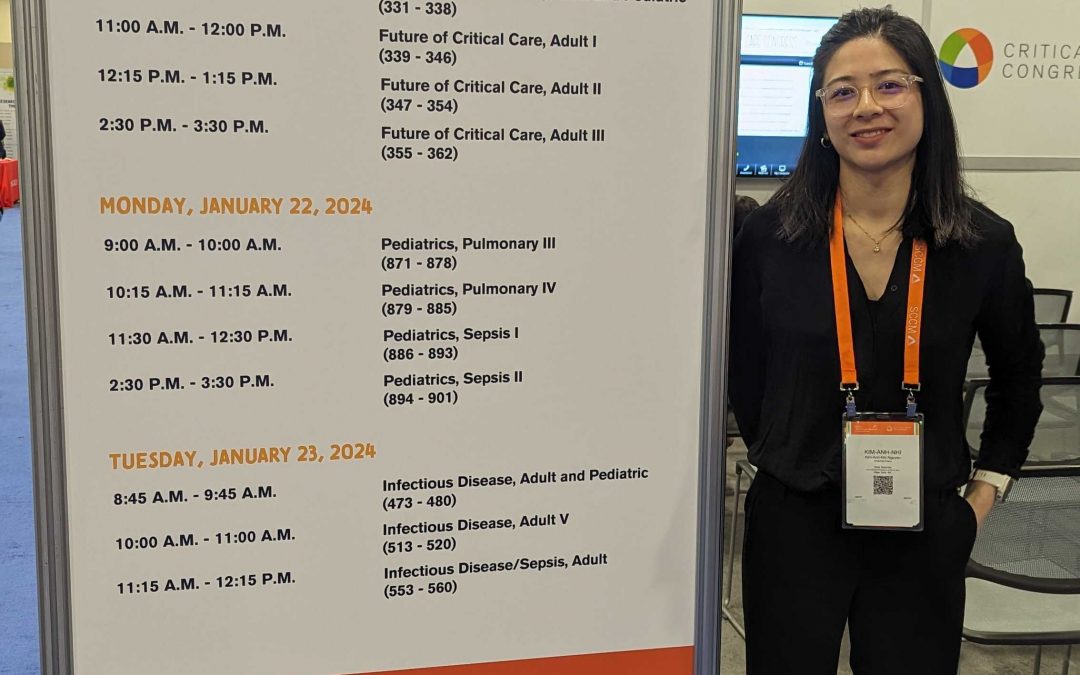The Clinical Data Science team, represented by our data scientist Kim-Anh-Nhi Nguyen, MSc, presented the paper “A Deep Learning Model using Chest X-Rays to Predict Re-Intubation Risk in Critical Care” at the 2024 Critical Care Congress in Phoenix, Arizona.
More details of presentation can be found below:
2024 Critical Care Congress
Category: Future of Critical Care
Title: A Deep Learning Model using Chest X-Rays to Predict Re-Intubation Risk in Critical Care
Author(s)
Kim-Anh-Nhi Nguyen, MSc (Role: First Author)
Pranai Tandon, MD (Role: Co-Author)
Masoud Edalati, PhD (Role: Co-Author)
ARASH KIA, MD, MSc (Role: Co-Author)
Kim-Anh-Nhi Nguyen, MSc (Role: First Author)
Pranai Tandon, MD (Role: Co-Author)
Masoud Edalati, PhD (Role: Co-Author)
ARASH KIA, MD, MSc (Role: Co-Author)
Abstract
INTRODUCTION
The decision to extubate is critical; however, there is no gold-standard readiness test, and simultaneously many patients fail trials of extubation while other patients’ readiness to liberate is unrecognized by clinicians. Machine learning models using EHR data are proliferating to provide clinical decision support in ventilator liberation; however, they fail to incorporate the breadth of information available to clinicians. We develop and validate a deep learning model to predict risk of re-intubation among medically critically ill patients on mechanical ventilation using routinely collected Chest X-Rays (CXR).
METHODS
We included adult patients admitted to the Mount Sinai Hospital medical ICU between 2011 and 2019, intubated via endotracheal tube for more than 24 hours, and underwent a trial of extubation. We excluded patients who were supported on mechanical ventilation via tracheostomy, pregnant patients and palliative extubation. Raw DICOM images of CXR in upright and supine position were extracted from the institutional PACS server. The CXRs were then cleaned, normalized and segmented. For each patient, the last CXR before the extubation was kept. The dataset was split into a train and a test set with 80/20% split and the train set was augmented. Transfer learning with fine-tuning and K-fold cross-validation was used on a pretrained ResNet50 deep learning architecture. To interpret our image classifier, we used the Grad-CAM method.
RESULTS
There were 1640 patients in the train set and 444 patients in the test set, the extubation success rate was 88% in the whole cohort. The final model provided 68.4% (95% CI: 61. 5%-74.6%) sensitivity, 56.9% (95% CI: 36.8%-75.9%) specificity, 67.1% (95% CI: 61.3%- 73.4%) accuracy, and 0.68 (95% CI: 0.56-0.78) area under the receiver operating characteristics curve (AUROC) on the test set.
CONCLUSIONS
Routinely available CXR can be used with deep learning in reintubation risk prediction and can be used in combination with EHR models for clinical decision support. Combining tabular data EHR models and Deep Learning models may provide synergy in prediction performance. Multimodal models fusing imaging and tabular data is the frontier of AI in healthcare.
The decision to extubate is critical; however, there is no gold-standard readiness test, and simultaneously many patients fail trials of extubation while other patients’ readiness to liberate is unrecognized by clinicians. Machine learning models using EHR data are proliferating to provide clinical decision support in ventilator liberation; however, they fail to incorporate the breadth of information available to clinicians. We develop and validate a deep learning model to predict risk of re-intubation among medically critically ill patients on mechanical ventilation using routinely collected Chest X-Rays (CXR).
METHODS
We included adult patients admitted to the Mount Sinai Hospital medical ICU between 2011 and 2019, intubated via endotracheal tube for more than 24 hours, and underwent a trial of extubation. We excluded patients who were supported on mechanical ventilation via tracheostomy, pregnant patients and palliative extubation. Raw DICOM images of CXR in upright and supine position were extracted from the institutional PACS server. The CXRs were then cleaned, normalized and segmented. For each patient, the last CXR before the extubation was kept. The dataset was split into a train and a test set with 80/20% split and the train set was augmented. Transfer learning with fine-tuning and K-fold cross-validation was used on a pretrained ResNet50 deep learning architecture. To interpret our image classifier, we used the Grad-CAM method.
RESULTS
There were 1640 patients in the train set and 444 patients in the test set, the extubation success rate was 88% in the whole cohort. The final model provided 68.4% (95% CI: 61. 5%-74.6%) sensitivity, 56.9% (95% CI: 36.8%-75.9%) specificity, 67.1% (95% CI: 61.3%- 73.4%) accuracy, and 0.68 (95% CI: 0.56-0.78) area under the receiver operating characteristics curve (AUROC) on the test set.
CONCLUSIONS
Routinely available CXR can be used with deep learning in reintubation risk prediction and can be used in combination with EHR models for clinical decision support. Combining tabular data EHR models and Deep Learning models may provide synergy in prediction performance. Multimodal models fusing imaging and tabular data is the frontier of AI in healthcare.

